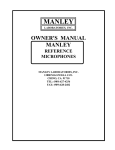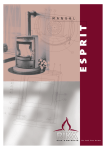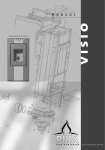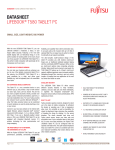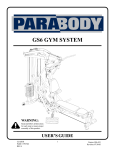Download Manley Cardioid Owner`s manual
Transcript
MANLEY REFERENCE MICROPHONES Reference Cardioid Reference Mono Gold Reference Stereo Gold OWNER’S MANUAL rev9-2-11cd CONTENTS SECTION PAGE INTRODUCTION3 POWER SUPPLY 4 MICROPHONE CONTROLS 5 GENERAL NOTES 6 MAINS CONNECTIONS 7 TROUBLESHOOTING8 STEREO GOLD ADDENDUM 9 SPECIFICATIONS 10 VOLTAGE CONVERSION 11 INTRODUCTION THANK YOU!... ...for choosing a Manley Laboratories REFERENCE SERIES MICROPHONE. This manual covers the following models: Reference Cardioid, Reference Mono Gold, and Reference Stereo Gold. GENERAL NOTES Manley microphones will beat all others on grounds of sheer naturalness of sound without coloration or perceivable sonic signature. The design is optimized for extremely wide frequency response and exceptionally accurate transient response. Visually impressive, the Mics inspire confidence in artists and producers. The Reference Gold’s microphone body is machined from brass providing excellent shielding properties, polished to a high lustre, then plated with 24 karat gold for an impressive finish. The Reference Cardioid has a classic black anodized aluminum casing. We have chosen a very open weave stainless-steel grille for the capsule window for zero-loss acoustical transmission. You may notice the that the capsule will move slightly when the Microphone is moved. This is a second defense to prevent unwanted vibrations from being picked up by the capsule. The capsule itself is mounted onto a neoprene-rubber shock-mount such as those used for aerospace gyroscopes. The Manley Gold Reference Multi-Pattern Microphones use our own design of large diaphragm capsule (1.25 inch overall, 1 inch diaphragm diameter) which are executed to precise tolerances made possible by modern micro-milling machinery available today in California. The capsule rings and back-plates are milled from solid brass and are mounted on Teflon insulator rings. The gold diaphragm film comes from Germany and is tensioned using proprietary techniques which ensures capsule-to-capsule constancy. We have found the 5 micron gauge gold film to exhibit inherently stable characteristics over years (unlike thinner diaphragms) while still maintaining the speed, “air”, and ultrahigh frequency response. (The Reference Cardioid uses 6 micron on its one “live” side.) The tube electronics found in the Manley Reference Series Microphones consist of two triodes per capsule in cascade forming an entire gain-block. The tube employed is a dual-triode 12AT7, easily obtainable and replaceable, mounted in a ceramic socket with pure silver pins. The output is coupled through a custom built output transformer of unparalleled quality and substantial physical size employing pure nickel laminations, “humbucking” bi-filar windings, all encased in mu-metal. The polar pattern control is continuously variable between the OMNI, CARDIOID, and FIGURE 8 positions on the Gold series. The base of both the Reference Gold and the Reference Cardioid microphones houses a 6-pin connector which carries power and signal between the power supply and the mic itself. The audio is picked off at the supply, and then delivered to the mic pre via an XLR output. Our precision suspension system is provided with each REFERENCE MICROPHONE. Because the entire working “guts” of the microphone may be removed for service in one piece from the housing, it is envisioned that the microphone need not be removed from the suspension. We also provide a very useful swivel of our own design with every microphone; its T-bar handle and locking clutch action require no tools to adjust. 3 The open mesh design of the mic allows all the highs to reach the capsule unimpared and allows the engineer to choose if, when and how much pop screen is appropriate. Vocal “pops” may distort the capsule without a pop screen. Air movement and wind can overload a good capacitor mic capsule much easier than loud levels.We strongly recommend a good 2 layer nylon pop screen with this mic on close vocals. A built in foam screen needs built in HF boost - not here. Of course, no Manley microphone would be complete without a genuine leather capsule protector which slips (and ties) onto the end of the microphone to protect the capsule when not in use. Each Reference Microphone is packaged complete in a sturdy case. The STEREO version of our GOLD REFERENCE microphone is identical in every respect to the MONO GOLD REFERENCE but with two complete systems installed in one case with the upper capsule being fixed and the lower capsule being continuously ROTATABLE through 90° for M-S and X-Y BLUMLEIN-STYLE coincident pair recording technique. Each capsule has its own continuously variable PATTERN control and individual -10dB PAD switch for close miking of extra-ordinarily powerful brass and other instruments. Also, due to the power and audio requirements of having two complete microphone systems in one housing, the stereo mic has a dedicated 4-pin power cable that goes to the base of the mic. Audio is carried out from a single jack that is then split into two separate XLR cables (see page 9 for details). POWER SUPPLY POWER SUPPLY (Reference Cardioid and Mono Reference Gold) FRONT A BACK B C D E F A. Power light: When power is on, this light will glow red. When power is off, this light will, in fact, not glow at all. A. Power light: When power is on, this light will glow red. When power is off, this light will, fact, not glow at all. B. IEC Power in Connector: Connector for AC power input. C.IEC Fuse Holder: ReplaceConnector with 250mA fuse for 100-120V operation, B. Power Connector: for ACSLO-BLO power input. or 125mA SLO-BLO fuse for 220-240V operation. This PSU uses 5x20mm fuses. C. Fuse Holder: Replace with 1A SLO-BLO fuse for 120V operation, or 1/2A SLO-BLO for 220V. This PSU uses “half-sized” fuses. D. Power Switch: Pressing this switch up will turn the supply on. D. Power Switch: Pressing this switch up will turn the supply on. E. 6-Pin Microphone Cable Input: Where the supplied power/audio cable is attached. E. 6-pin Microphone Cable Input: Where the supplied power/audio cable is inserted. F: XLR Out to Micpre: Where the XLR cable goes out to your micpreamp. F. XLR Out to Micpre: Where the XLR cable goes out to your very favorite micpre. 4 SPECIFICATIONS (GOLD SERIES) MICROPHONE TYPE: DUAL LARGE DIAPHRAGM CAPACITOR MICROPHONE CONTROLS A: PATTERN SELECT CONTROL (GOLD MODELS) OMNI FIGURE 8 CARDIOID This control provides the user with a choice of any typical polar pattern. Many high quality condenser microphones give the user 3 or 4 patterns only; we chose to provide you with an infinite number of patterns via this control. For example, a setting between the “heart shaped” CARDIOID and FIGURE 8 will result in “SUPER-CARDIOID” and “HYPER-CARDIOID” patterns. ***Remember that proximity effect is primarily affected by the polar pattern. Often with vocalists, one wants a certain amount of bass boost associated with certain mics and certain distances. Rather than just hoping that the CARDIOID setting will do the right thing, this time try adjusting the PATTERN SELECT POT to “dial in” the amount of proximity effect for this particular vocal. More OMNI will give less proximity effect, while more FIGURE 8 will bring in more lows. In other words, while this is only true for close miking, the PATTERN SELECT can be an effective bass control.*** TIP: You may notice that as the pattern becomes more FIGURE 8 that certain air conditioning rumbles and room noise exibit reduced pick-up. Conversely, if you want more room sound, try moving the pattern select closer to OMNI... Compared to many microphones, the Manley Reference Gold Microphones exibit less proximity effect for a given close distance. This, we feel is a clear advantage. Most engineers we consulted preferred the options of bass control from the console rather than the typical situation where a few inches of distance can make or break a take. We also chose to allow the frequency response of the Reference Mics to extend below 20 Hz. Some mics seem to have a low frequency resonance that can be desirable at times while boomy or tubby at other times. Our goal is “flat and natural”. B: - 10 dB PAD SWITCH (ALL MODELS) 0 dB -10 dB This tiny switch near the base of the microphone body reduces the signal by 10 dB. Rather than changing the capsule voltage or adding a resistor into the signal path we chose a better technique. We change the amount of negative feedback derived from a dedicated transformer winding. While the tube circuit will handle any signal the capsule can deliver the pad may be needed with some pre-amps. If you suspect that the mic is distorting, first try a different mic pre. The capsule is rated for 150 dB SPL but wind or air movement are exceptions. A pop filter will be needed for close vocals. 5 GENERAL NOTES CONNECTIONS MONO REFERENCE GOLD & REFERENCE CARDIOID MODELS - connect 6-pin cable (supplied with mic) between PSU and mic. Audio comes from separate 3 pin XLR on the PSU. STEREO REFERENCE GOLD MODEL - carefully connect the 4 pin power cables to the mic and power supply. Line up the groove and ridge of these connectors to prevent accidental damage. Next connect a known good mic cable to the power supply, and you’re ready to record. If possible, use a short cable and a high quality microphone preamplifier (with the phantom power turned off) located near the mic. This is usually the best for audio quality. Try to avoid running the mic signal thru a patch bay or extra connectors and wires. Attach the mic securely to a good mic stand and and lay the cables so that people cannot trip over the cable or topple the stand. Connect the power supply to the wall outlet and turn on the supply. Let the mic warm up for at least 5 minutes before using. If any of the connections at the base of the microphone become loose over time, they can be easily tightened with a 1/16” allen key. WATER & MOISTURE As with any electrical equipment, this unit should not be used near water or moisture. In rare situations moisture from breath may temporarily cause loss of output from condenser mics. Do not use a blower or heat to accelerate drying. Extreme humidity may comprimise the performance of some high value ( 500 MΩ and 200 MΩ ) resistors in the circuit. If liquid enters the unit, it must be immediately returned to your dealer for servicing. SERVICING The user should not attempt to service this unit beyond that described in the owner’s manual. Refer all servicing to Manley Laboratories. WARNING! TO PREVENT THE RISK OF ELECTRIC SHOCK, DO NOT OPEN THE POWER SUPPLY CABINET OR REMOVE THE SHELL FROM THE MICROPHONE. -------- HIGH VOLTAGES -------REFER SERVICING TO QUALIFIED PERSONEL www.manley.com/service.php 6 MAINS CONNECTIONS Your REFERENCE MICROPHONE Power Supply has been factory set to the correct mains voltage for your country. The voltage setting is marked on the serial badge, located on the underside of the power suppy. Check that this complies with your local supply. Export units for certain markets have a moulded mains plug fitted to comply with local requirements. If your unit does not have a plug fitted the coloured wires should be connected to the appropriate plug terminals in accordance with the following code: GREEN/YELLOWEARTH BLUENEUTRAL BROWNLIVE As the colours of the wires in the mains lead may not correspond with the coloured marking identifying the terminals in your plug proceed as follows: The wire which is coloured GREEN/YELLOW must be connected to the terminal in the plug which is marked by the letter E or by the safety earth symbol or coloured GREEN or GREEN and YELLOW. The wire which is coloured BLUE must be connected to the terminal in the plug which is marked by the letter N or coloured BLACK. The wire which is coloured BROWN must be connected to the terminal in the plug which is marked by the letter L or coloured RED. DO NOT CONNECT/SWITCH ON THE MAINS SUPPLY UNTIL ALL OTHER CONNECTIONS HAVE BEEN MADE. Note: Units are purpose built for original destination country’s mains voltage: 100V, 120V, or 220-240VAC as indicated on the serial number badge. Power transformer can be rewired for another country’s mains voltage via internal jumpers and fuse change. See page 11 for details. 100V and 120V operation: 250mA SLO-BLO fuse. 220-240V operation: 125mA SLO-BLO fuse. ***Fuses for ALL VOLTAGES are 5x20mm GDC packaged fuses.*** Waste Electrical and Electronic Equipment (WEEE) Information for customers: The European Parliament and the Council of the European Union have issued the Waste Electrical and Electronic Equipment Directive. The purpose of the Directive is the prevention of waste of electrical and electronic equipment, and to promote the reuse and recycling and other forms of recovery of such waste. As such the Directive concerns producers, distributors and consumers. The WEEE directive requires that both manufacturers and end-consumers dispose of electrical and electronic equipment and parts in an environmentally safe manner, and that equipment and waste are reused or recovered for their materials or energy. Electrical and electronic equipment and parts must not be disposed of with normal household wastage; all electrical and electronic equipment and parts must be collected and disposed of separately. Products and equipment which must be collected for reuse, recycling and other forms of recovery are marked with the following pictogram: Small products may not always be marked with this pictogram in which case this is present in the instructions for use, on the guarantee certificate and printed on the packaging. When disposing of electrical and electronic equipment by use of the collection systems available in your country, you protect the environment, human health and contribute to the prudent and rational use of natural resources. Collecting electrical and electronic equipment and waste prevents the potential contamination of nature with the hazardous substances which may be present in electrical and electronic products and equipment. Your MANLEY or LANGEVIN retailer will assist with and advise you of the correct way of disposal in your country. 7 TROUBLESHOOTING NO POWER, NO INDICATORS, NADA - Probably something to do with AC power. Is it plugged in? Murphy’s Law. Check the fuse on the back panel. A blown fuse often looks blackened inside or the little wire inside looks broken. A very blackened fuse is a big hint that a short occured. Try replacing the fuse with a good one of the same value and size. If it blows too then prepare to send the unit back to the dealer or factory for repair. The fuse is a protection device and it should blow if there is a problem. If the unit works with a new fuse, fine. LIGHTS BUT NO SOUND - This typically indicates a cabling problem. Check to ensure the XLR mic cables you are using are not damaged. If the XLR and micpreamp (and the rest of the signal path) are known to be good, it may be the mic. LEVELS SEEM TO BE WRONG, NO BOTTOM - Most likely one of two scenarios. One, a partially broken cable. You would then be missing half the balanced signal, and levels would be down approximately -6dB. Second possibility, the signal’s polarity has been reversed somewhere. Try flipping the phase on your micpreamp (if it has a phase switch), and see if that helps. **Put on some headphones, close your eyes, and speak into the mic from a distance of about one foot. Your voice should be full and clear with a solid low-end. With the phase reversed, this solidity goes away and your voice will sound like it is swimming all around your head with no clearly defined center image.** HUM - This is most likely a ground loop. Try a 3-pin to 2-pin AC adaptor (about a dollar at a hardware store). We do not recommend breaking off the power cable’s grounding pin. BUZZ - This is most likely a faulty ground somewhere in the chain. Make sure all the philips screws holding the mic body to the mic base are tight. Stereo models or older models might have loose set-screws that hold and ground the connectors to the body system. Use a 1/16” hex key to tighten these set screws around the base of the microphone. It might also be the tube making a bad noise - read on... EXCESS NOISE, DISTORTION, SNAPS CRACKLES & POPS - Probably a tube. Luckily for you, they are very easy to change: 1. Turn the power supply off, disconnect it from the wall, and disconnect the 6-pin cable from the microphone. 2. Using a philips screwdriver, remove the two philips screws on the mic body that hold it to the base of the microphone. 3. Gently, gently pull the base of the mic out from inside the body. The guts of the mic will come out with it. 4. When you’ve pulled the insides all the way out (be VERY careful not to touch the delicate capsule!), you’ll clearly see the tube. (hint: it’s the glass bottle with some metal and no air inside it.) 5. Gently grasp the tube between your thumb and forefingers, and wiggle it out of the socket. 6. Taking care to align the pins properly, insert the new tube into the socket, and repeat these steps (again, CAREFULLY) to return the guts to the inside of the mic. Make sure to properly tighten the screws at the base for a good chassis ground connection! For additional information, contact our Service Department: www.manley.com/service.php 8 STEREO GOLD ADDENDUM PSU Power Supply: Instead of a six-pin power/audio connector, the Stereo Gold mic’s PSU holds merely a 4-pin power connector. When connecting the included cable, ensure each of the pins are oriented correctly. (The cable should screw on easily if the tab is lined up within the connector.) 4-pin power connector MIC BASE 6-pin audio connector Pin Out: 1. “Rotate” capsule Pin 2 (+) 2. “Rotate” capsule Pin 3 (-) 3. (GROUND) 4. “Fixed” capsule Pin 3 (-) 5. “Fixed” capsule Pin 2 (+) 6. (GROUND) INCLUDED Y-CABLE 1 6 5 2 3 4 FIXED XLR Male connectors (out to micpreamps) ROTATE 9 SPECIFICATIONS REFERENCE GOLD SERIES CAPSULE TYPE: DUAL LARGE DIAPHRAGM CAPACITOR POLAR PATTERNS: CONTINUOUSLY VARIABLE (omni through cardioid through Figure 8) DIAPHRAGM SIZE: 1 INCH; 1.25 INCH OVERALL DIAPHRAGM THICKNESS: 5 MICRON; GOLD SPUTTERED FREQUENCY RESPONSE: 10 HZ to 30 KHZ, AMPLIFIER to 60 KHZ MAXIMUM INPUT SPL: 150 dB SPL AT CAPSULE SENSITIVITY: 19mV/Pa AMPLIFIER TYPE: 2 TRIODE GAIN BLOCK LO Z OUTPUT ACTIVE COMPONENTS: (1) 12AT7 TUBE (2 for STEREO MICS) OUTPUT TYPE : TRANSFORMER COUPLED OUTPUT POLARITY: BALANCED XLR, PIN 2 HOT, PIN 3 LOW AMPLIFIER DISTORTION: LESS THAN .05 % AMPLIFIER NOISE: TYPICALLY -120 dB EIN (TUBE DEPENDENT) BODY: 24 KARAT GOLD OVER MACHINED BRASS REFERENCE CARDIOID CAPSULE TYPE: POLAR PATTERN: DIAPHRAGM SIZE: DIAPHRAGM THICKNESS: FREQUENCY RESPONSE: MAXIMUM INPUT SPL: SENSITIVITY: AMPLIFIER TYPE: ACTIVE COMPONENTS: OUTPUT TYPE: OUTPUT POLARITY: AMPLIFIER DISTORTION: AMPLIFIER NOISE: BODY: CENTER-FIXED LG. DIAPHRAGM CAPACITOR FIXED CARDIOID 1 INCH; 1.25 INCH OVERALL 6 MICRON; GOLD-SPUTTERED 10 HZ to 30KHZ 150 dB SPL AT CAPSULE 17mV/Pa 2 TRIODE GAIN BLOCK LO Z OUTPUT (1) 12AT7 TUBE TRANSFORMER COUPLED BALANCED XLR, PIN 2 HOT, PIN 3 LOW LESS THAN .05% TYPICALLY -120dB EIN (TUBE-DEPENDENT) BLACK ANODIZED ALUMINUM POWER SPECS (all models) POWER CONSUMPTION: 8.4 watts (REFCARD/REFGOLD) 100V and 120V operation: 250mA SLO-BLO fuse 220-240V operation: 125mA SLO-BLO fuse ***Fuses for ALL VOLTAGES are 5x20mm GDC packaged fuses.*** 10 VOLTAGE CONVERSION All servicing described below should be referred to a qualified technician. 1. Unplug PSU from wall and disconnect microphone cable(s). Let sit for at least 15 minutes to let the capacitors discharge. 2. Remove PSU cover, held in place by 4 x philips screws. 3. Observe the jumpers located on PCB0718B, and the accompanying diagram printed on the PCB itself. 4. For 100V: solder jumpers W2, W3, W6 For 120V: solder jumpers W1, W4, W6 For 220/230V: solder jumpers W2, W5 For 240V: solder jumpers W1, W5 Example 1: The board below is set for 120V operation: PCB0718B W6 W2 W4 W1 W5 Example 2: The board below is set for 220/230V operation: PCB0718B W6 W2 W4 W1 W5 5. BE SURE TO CHANGE THE FUSE TO THE APPROPRIATE VALUE BEFORE USING THE MICROPHONE: 100-120V: 250mA SLO-BLO 220-240V: 125mA SLO-BLO 11











